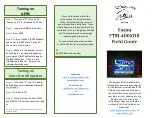
WSN Manual
Page 6 of 34
Rev. G
– 4 March 2007
glance the status of the product and the serial data port.
2.9.2
Time-out Timer
The transmitter within the WSN has a user programmable time-out timer which allows the
maximum continuous transmission time to be set in order to prevent channel blocking due to a
fault.
2.9.3
Power-Save Modes
The WSN has both internally controlled and externally controlled power-save modes to reduce
overall power consumption to extremely low levels for operation on sites without mains power.
2.9.4
Squelch Tail Elimination
As a user programmable option, the WSN can also operate in a packetisation mode where
framing characters are added at the start and end of the user's message prior to transmission
and stripped off again at the receive end prior to passing the user data to the interface
connector. This can be useful in getting rid of any spurious characters which may otherwise be
generated at the end of messages by squelch noise as the receiver mutes and which can affect
old or non-tolerant protocols.
In a high interference environment, enabling packetisation will often help to block reception of
the interfering signals.
2.9.5
Forward Error Correction
The WSN allows an optional forward error correction to be switched in when the over-air data
rate is 9,600bps. This will improve error performance, but there is an associated data
throughput overhead of around 30%, which therefore reduces the effective transmission rate for
the user data. The forward error corrector is not available at lower data rates, as it offers no
significant performance enhancement at these lower rates.







































